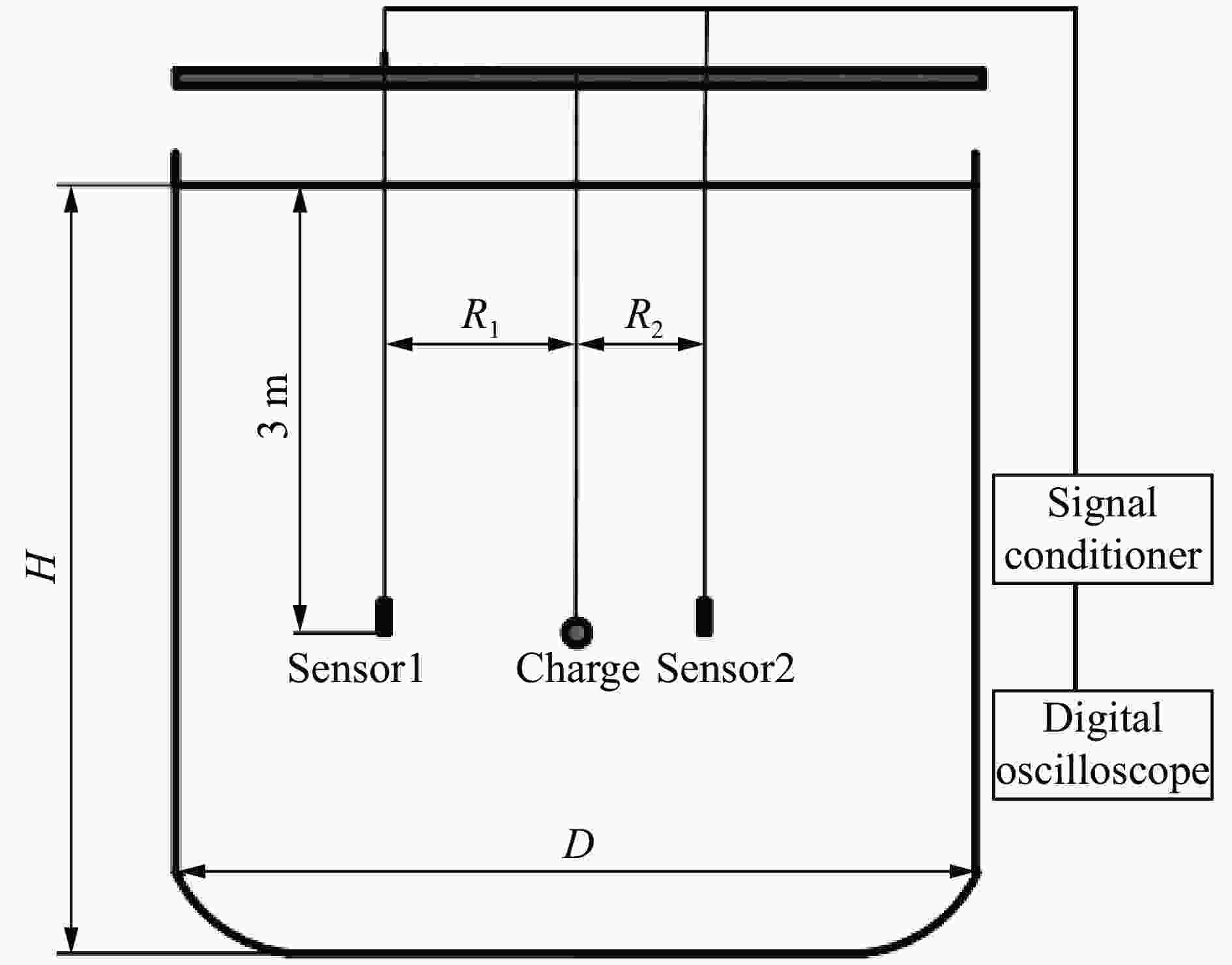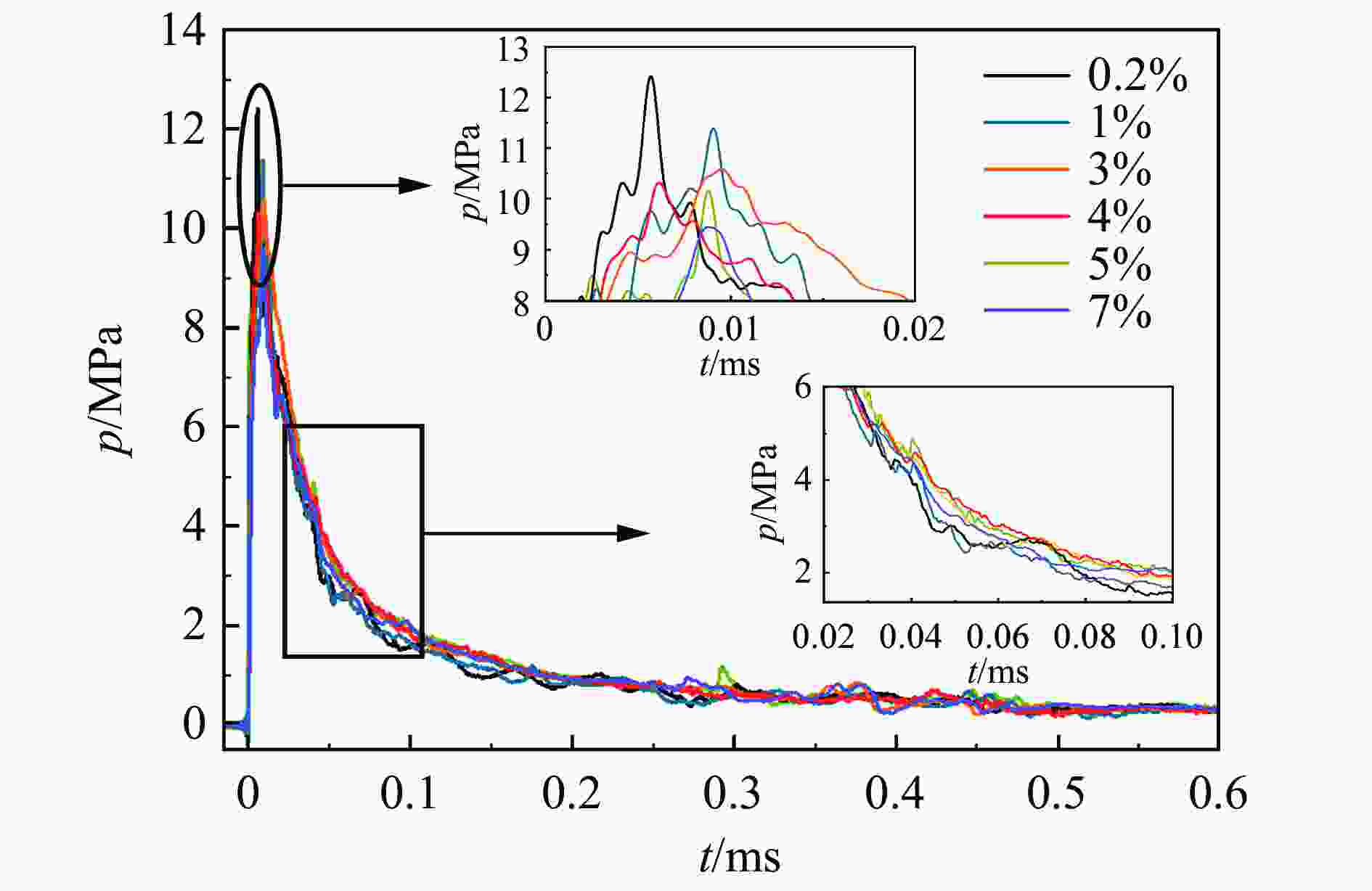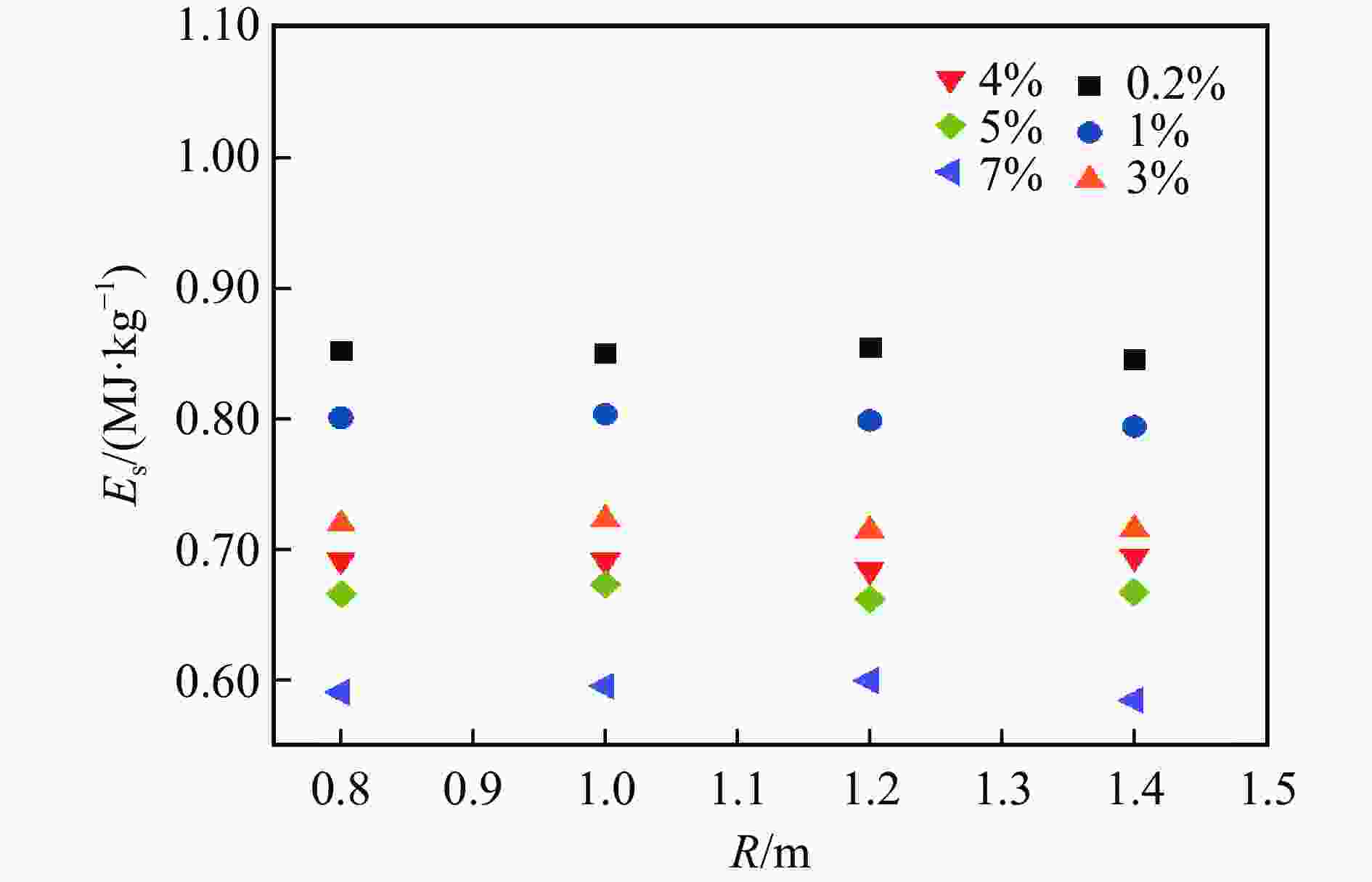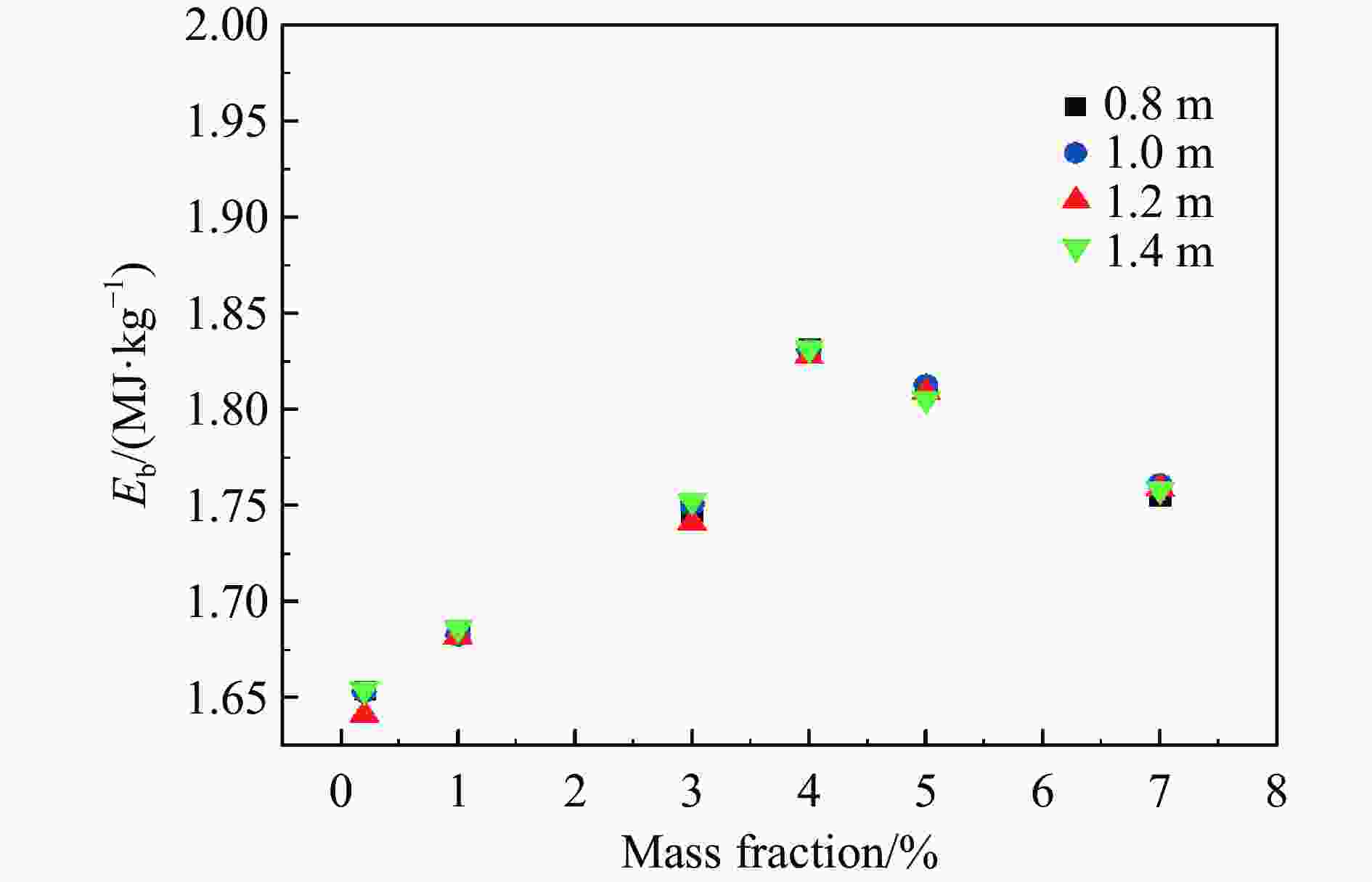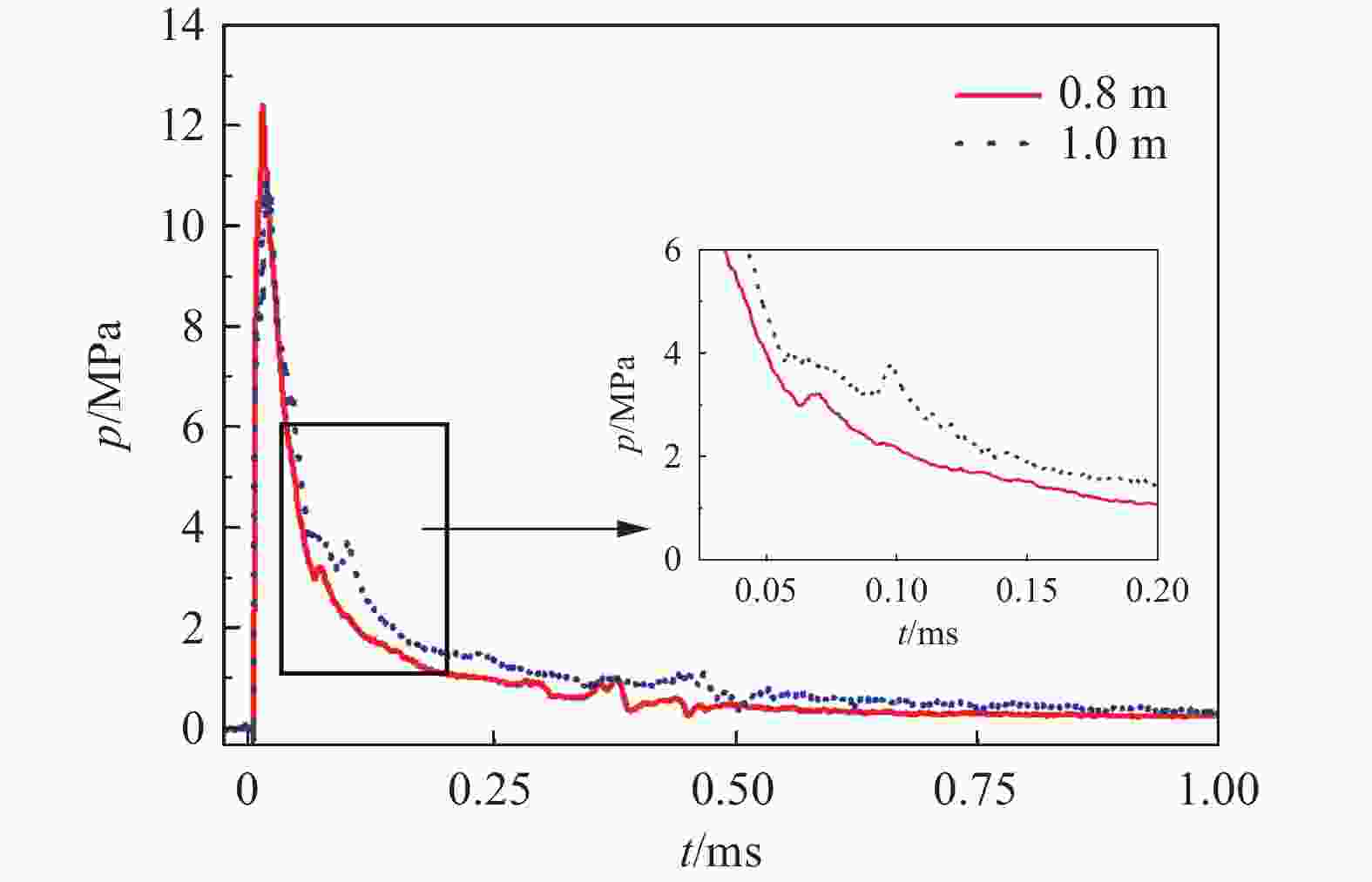Study on energy output characteristics of underwater explosion of energetic microballoon sensitized emulsion explosive
-
摘要: 将内部含有烷烃的含能微球引入乳化基质,得到一种新型乳化炸药。采用水下爆炸实验探究微球质量分数对乳化炸药水下爆炸性能的影响,得到含能微球质量分数为0.2%~7%的乳化炸药水下爆炸冲击波压力-时程曲线。依据压力结果,通过公式计算和分析得到炸药的水下冲击波峰值压力、比气泡能、比冲击波能以及比爆炸能等水下爆炸参数。实验结果表明:含能微球质量分数0.2%的乳化炸药的峰值压力最大,并且随着微球质量分数增大而下降;乳化炸药的比气泡能随着含能微球质量分数的增大先上升再下降,微球质量分数为4%的比气泡能最大;乳化炸药的爆速、比冲击波能以及比爆炸能均随着含能微球质量分数的增大而下降。Abstract: A new emulsion explosive was obtained by introducing energetic microballoons containing alkane into emulsion matrix. Energetic microballoons were foamed in a constant temperature environment of 90 ℃ for 5 min to reach the maximum volume, and then energetic microballoons were mixed with emulsion matrix to prepare emulsion explosive with the energetic microballoon contents from 0.2% to 7%. The detonation velocity of emulsion explosives with different microballoons was measured by detonation velocity meter. In a steel explosion vessel with a diameter of 5 m and a depth of 5 m, the explosives were placed at a depth of 3 m, which were 0.8, 1.0, 1.2 and 1.4 m away from sensor. The underwater explosion pressure-time curve of emulsion explosive with microballoon contents from 0.2% to 7% was obtained through underwater explosion experiment. The parameters of underwater explosion, such as shock wave peak pressure, specific shock wave energy, specific bubble energy and specific explosion energy, were obtained by analysis and calculation, which was used to explore the influence of energetic microballoon contents on the underwater explosion property of explosive. The results show that the peak pressure of emulsion explosive with microballoon content of 0.2% is the largest and decreases with the increase of microballoon contents at the same testing distance. The specific bubble energy of emulsion explosive increases firstly and then decreases with the increase of the microballoon contents, and the specific bubble energy is the largest when the microballoon content is 4%. The specific shock wave energy and specific explosion energy decrease as microballoon contents increase. The attenuation rate of underwater shock wave peak pressure is negatively correlated with propagation distance. However, the specific shock wave energy, special bubble energy and special explosion energy do not change with the increase of propagation distance.
-
表 1 乳化基质各组分的质量分数
Table 1. Mass fraction of compositions in emulsion matrix
NH4NO3 NaNO3 H2O C18H38 C24H44O6 71% 11.5% 11% 3.7% 2.8% 表 2 不同含能微球质量分数的乳化炸药配比
Table 2. Ratio of emulsion explosive with different energitic microballoon mass fractions
编号 微球质量分数/% 密度/(g·cm−3) 乳化基质 含能微球 1 100 0 1.26 2 99.95 0.05 1.26 3 99.9 0.1 1.26 4 99.8 0.2 1.25 5 99.5 0.5 1.18 6 99 1 1.08 7 97 3 0.92 8 96 4 0.88 9 95 5 0.81 10 93 7 0.60 11 92 8 0.54 12 91 9 0.49 表 3 不同微球质量分数下乳化炸药爆速
Table 3. Detonation velocity of emulsion explosives with different mass fraction of microballoon
质量分数/% 爆速/(m·s−1) 质量分数/% 爆速/(m·s−1) 0 − 3 3903 0.05 − 4 3537 0.1 − 5 3312 0.2 5150 7 3058 0.5 4911 8 2948 1 4807 9 − 注:“−”代表拒爆 表 4 不同微球质量分数的乳化炸药压力峰值拟合系数
Table 4. Fit coefficient of pressure peak value of emulsion explosives with different mass fraction of microballoon
质量分数/% α k 0.2 0.57276 21.46552 1 0.55114 19.27505 3 0.56847 18.21896 4 0.62795 17.36348 5 0.64058 18.64361 7 0.61182 18.44948 表 5 乳化炸药水下爆炸能量输出参数
Table 5. Parameters of underwater explosion energy of emulsion explosives
质量分数/% R/m pm/MPa Es/(MJ·kg−1) tb/ms Eb/(MJ·kg−1) μ Et/(MJ·kg−1) 0.2 0.8 12.4181 0.8525 73.5838 1.6542 1.725 3.1248 1.0 11.0536 0.8507 73.5731 1.6533 1.725 3.1208 1.2 9.9420 0.8549 73.3945 1.6417 1.725 3.1164 1.4 8.9700 0.8458 73.5891 1.6543 1.725 3.1133 1 0.8 11.3915 0.8009 74.0442 1.6847 1.606 2.9709 1.0 10.1839 0.8036 74.0207 1.6829 1.606 2.9735 1.2 9.1365 0.7989 74.0069 1.6822 1.606 2.9652 1.4 8.3646 0.7943 74.0731 1.6864 1.606 2.9620 3 0.8 10.5915 0.7196 74.9639 1.7468 1.392 2.7485 1.0 9.4157 0.7233 75.0252 1.7508 1.392 2.7576 1.2 8.4793 0.7149 74.8831 1.7413 1.392 2.7364 1.4 7.6756 0.7158 75.0562 1.7528 1.392 2.7492 4 0.8 10.3247 0.6918 76.1943 1.8324 1.320 2.7456 1.0 9.0344 0.6911 76.1755 1.8312 1.320 2.7435 1.2 8.0263 0.6841 76.1255 1.8279 1.320 2.7309 1.4 7.3504 0.6942 76.1834 1.8317 1.320 2.7347 5 0.8 10.1623 0.6659 76.0029 1.8102 1.287 2.7006 1.0 8.8041 0.6728 75.9683 1.8129 1.287 2.6978 1.2 7.8125 0.6616 75.9812 1.8092 1.287 2.6907 1.4 7.1149 0.6672 75.9458 1.7907 1.287 2.6954 7 0.8 9.6041 0.5905 75.1226 1.7552 1.174 2.4484 1.0 8.2501 0.5951 75.1763 1.7612 1.174 2.4598 1.2 7.4570 0.5993 75.1443 1.7590 1.174 2.4625 1.4 6.7446 0.5842 75.1343 1.7584 1.174 2.4442 -
[1] 汪旭光. 乳化炸药 [M]. 北京: 冶金工业出版社, 1993: 1−15. [2] LOUREIRO A, MENDES R, RIBEIRO J B, et al. Effect of explosive mixture on quality of explosive welds of copper to aluminium [J]. Materials & Design, 2016, 95: 256–267. DOI: 10.1016/j.matdes.2016.01.116. [3] BIEGAŃSKA J. Using nitrocellulose powder in emulsion explosives [J]. Combustion, Explosion, and Shock Waves, 2011, 47(3): 366–368. DOI: 10.1134/S0010508211030154. [4] 张学民, 周贤舜, 王立川, 等. 大断面隧道钻爆冲击波的衰减规律 [J]. 爆炸与冲击, 2020, 40(2): 025101. DOI: 10.11883/bzycj-2019-0045.ZHANG X M, ZHOU X S, WANG L C, et al. Attenuation of blast wave in a large-section tunnel [J]. Explosion and Shock Waves, 2020, 40(2): 025101. DOI: 10.11883/bzycj-2019-0045. [5] MISHRA A, ROUT M, SINGH D R, et al. Influence of density of emulsion explosives on its velocity of detonation and fragmentation of blasted muckpile [J]. Current Science, 2017, 112(3): 602–608. DOI: 10.18520/cs/v112/i03/602-608. [6] CHENG Y F, MENG X R, FENG C T, et al. The effect of the hydrogen containing material TiH2 on the detonation characteristics of emulsion explosives [J]. Propellants, Explosives, Pyrotechnics, 2017, 42(6): 585–591. DOI: 10.1002/prep.201700045. [7] 钱海, 吴红波, 邢化岛, 等. 铝粉含量和粒径对乳化炸药作功能力的影响 [J]. 火炸药学报, 2017, 40(1): 40–44. DOI: 10.14077/j.issn.1007-7812.2017.01.008.QIAN H, WU H B, XING H D, et al. Effect of aluminum content and particle size on the power of emulsion explosives [J]. Chinese Journal of Explosives & Propellants, 2017, 40(1): 40–44. DOI: 10.14077/j.issn.1007-7812.2017.01.008. [8] 陈海军, 马宏昊, 沈兆武, 等. 钛基纤维炸药水下爆炸性能的初步分析 [J]. 爆炸与冲击, 2018, 38(1): 9–18. DOI: 10.11883/bzycj-2017-0155.CHEN H J, MA H H, SHEN Z W, et al. Preliminary analysis of underwater detonation performance of titanium fiber explosive [J]. Explosion and Shock Waves, 2018, 38(1): 9–18. DOI: 10.11883/bzycj-2017-0155. [9] 程扬帆, 汪泉, 龚悦, 等. 敏化方式对MgH2型储氢乳化炸药爆轰性能的影响 [J]. 含能材料, 2017, 25(2): 167–172. DOI: 10.11943/j.issn.1006-9941.2017.02.013.CHENG Y F, WANG Q, GONG Y, et al. Effect of sensitizing methods on the detonation performances of MgH2-based hydrogen storage emulsion explosives [J]. Chinese Journal of Energetic Materials, 2017, 25(2): 167–172. DOI: 10.11943/j.issn.1006-9941.2017.02.013. [10] SIL’VESTROV V V, BORDZILOVSKII S A, KARAKHANOV S M, et al. Temperature of the detonation front of an emulsion explosive [J]. Combustion, Explosion, and Shock Waves, 2015, 51(1): 116–123. DOI: 10.1134/S0010508215010128. [11] FANG H, CHENG Y F, TAO C, et al. Effects of content and particle size of cenospheres on the detonation characteristics of emulsion explosive [J]. Journal of Energetic Materials, 2021, 39(2): 197–214. DOI: 10.1080/07370652.2020.1770896. [12] WANG Y X, MA H H, SHEN Z W, et al. Influence of different gases on the performance of gas-storage glass microballoons in emulsion explosives [J]. Propellants, Explosives, Pyrotechnics, 2020, 45(10): 1566–1572. DOI: 10.1002/prep.202000105. [13] YUNOSHEV A S, PLASTININ A V, RAFEICHIK S I. Detonation velocity of an emulsion explosive sensitized with polymer microballoons [J]. Combustion, Explosion, and Shock Waves, 2017, 53(6): 738–743. DOI: 10.1134/S0010508217060168. [14] BARNES R A, HETHERINGTON J G, SMITH P D. The design and instrumentation of a simple system for demonstrating underwater explosive effects [J]. Propellants, Explosives, Pyrotechnics, 1988, 13(1): 13–16. DOI: 10.1002/prep.19880130104. [15] COLE R H. Underwater explosions [M]. Princeton: Princeton University Press, 1948: 110−113. [16] BJARNHOLT G. Suggestions on standards for measurement and data evaluation in the underwater explosion test [J]. Propellants, Explosives, Pyrotechnics, 1980, 5(2−3): 67–74. DOI: 10.1002/prep.19800050213. [17] 薛冰. RDX基金属氢化物混合炸药爆炸及安全性能研究 [D]. 合肥: 中国科学技术大学, 2017: 72−73.XUE B. Explosion and safety performance of RDX-based metal hydride composite explosives [D]. Hefei: University of Science and Technology of China, 2017: 72−73. -







 下载:
下载:

